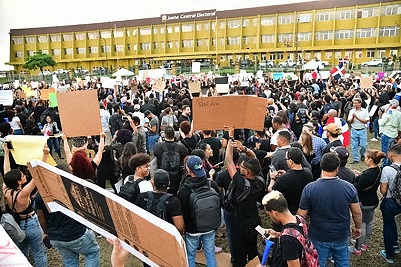Protests erupted in the Dominican capital of Santo Domingo last month after a Feb. 16 municipal election was suddenly cancelled due to technical difficulties. The election was suspended by officials four hours after voting began due to alleged issues with electronic voting technology.
Within hours, protesters filled the streets of Santo Domingo carrying signs calling for “democracy” and “punishment for the corrupt.” Many protesters say that the alleged technical difficulties mask an attempt by the Dominican Liberation Party to maintain its power against the will of the people, according to a recent report by independent news outlet Democracy Now!
Many protesters expressed distrust towards the PLD, which has—with the exception of a brief period from 2000–2004—held uninterrupted power in the Dominican Republic since 1996. The New York Times reported one of the key issues with electronic voting which triggered the election suspension on Feb. 16 was the absence of parties other than the PLD on electronic ballots.
The island nation’s modern history shows the fluctuation of democratic institutions and dictatorial rule. From 1930 to 1961 the Dominican Republic was governed by military dictatorship under Gen. Raphael Trujillo, who received training from the U.S. Marines in the 1910s. The U.S. military occupied the Dominican Republic from 1916 to 1924.
Following a U.S.–backed coup d’état and second military occupation in 1965 and 1966, Joaqín Balaguer was installed as president, serving off and on in that role until the mid-1990s, when the PLD came to power. Under Balaguer’s U.S.-backed regime, some 11,000 Dominicans were tortured, killed or disappeared.
“People are already seeing the connection between [Balaguer’s] time in the presidency and how long the PLD has been in power and how they have crushed the opposition,” said Amanda Alcántara, a Dominican-American journalist, in a recent interview with Democracy Now!
“People see [the suspended election] as an attempt at sabotage,” she said. “This is the first time in 18 years, or the first time at least in a decade, that the PLD is no longer ahead in the polls, when instead, it’s the opposition party.”
The recent voting snafu has raised questions concerning government spending and wealth distribution, issues which have historically brought Dominicans into the streets en masse. In 2017, a bribery case involving top Dominican officials triggered a wave of protests in which tens of thousands of Dominicans voiced dissatisfaction with government misconduct. The electronic voting machines used in the Feb. 2020 election cost the Dominican government some 19 million dollars. This has caused outrage, as more than a third of the population in the Domincan Republic live on $1.25 (USD) per day or less, and nearly 20% live in even more extreme poverty.
Dominican election officials announced they will be returning to paper ballot voting in upcoming elections and have called upon the Organization of American States (OAS) to perform a “complete and binding” audit of all election results, according to The New York Times.
Election officials rescheduled the suspended election for March 15 and plan to use paper ballots to prevent further issues reports TeleSUR. Questions remain unanswered about the nature and extent of the blunder. With a national presidential election coming in May, many are putting pressure on election officials to establish sound voting procedures and restore public trust.
“The government has no other choice but to hold fair elections,” Alcantara said. “If the elections are not fair and if they’re not transparent, which is what the people are demanding, I think the protests are just going to continue.”
